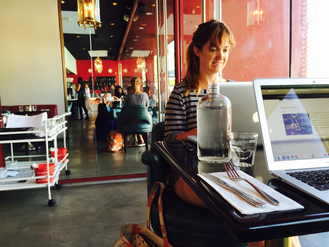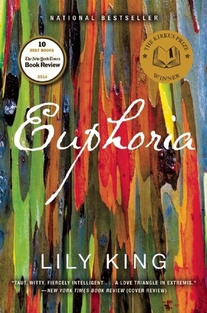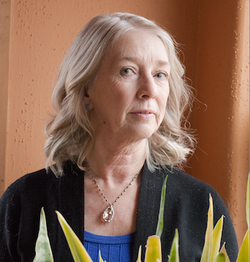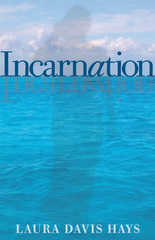
I do too. I am intent on my story or my next book and I have momentum from the group energy. I get up from time to time and have a refill or buy another snack, but it doesn’t last long because I need to get back and get the next thought typed into my MacBook Air.
I starting doing this back in the late 1980’s when my friend Susana was a student (and friend) of Natalie Goldberg, and Natalie’s iconic book, Writing Down the Bones, was starting its miraculous climb on the charts and her workshops were gaining momentum. (Writing Down the Bones has since sold over one million copies.)
Natalie’s idea was revolutionary. Zen inspired, Natalie saw writing as a practice that’s ninety percent listening. You go for “first thoughts,” keep your hand moving, don’t cross out or edit, don’t judge. Just write. My friend Jeanne describes the retreats as, “Shut up and write weekends.”
The reason Writing Practice is so good is because you are so good and now you are open and the words are simply flooding out from a hidden source and you are following a discipline. Natalie’s passion and quirky voice helps too. But when you’re writing, you need to forget Natalie and your friend Susana sitting across from you and the noise around you and whatever it is you’re eating or drinking, and just follow that thought. It may lead you someplace you never thought you’d go.

I don’t remember what we were writing then, but now we are working on our deep material that we’ve gotten to after all this time. Susana and I met again recently at a crowded Starbucks on a cold October morning, the day after a heavy storm. I was editing, not doing writing practice, rather combing through looking for places the story didn’t quite satisfy, but I got to some new stuff, and gained momentum on that story called The Lighthouse. Susana was writing another play about her French friend Veronique and their childhood together in France. Both of us are mature writers. Both of us know a thing or two.
Why don’t I write at home in my beautiful study with a view?
I do, of course, but I like to mix it up these days.
My daughter-in-law, Holly, has two little girls and an interesting job working for HGTV, re-writing content for the website. Sadie goes to kindergarten now, but Gemma, age two, is still at home. So Babs comes two or three times a week to watch Gemma, and Holly goes to a café with her computer to work. Since this is the ONLY time she has to work (other than when the girls are sleeping, and who needs to sleep then anyway?) she has to make the time count.
I’ve been lucky enough to go along on my recent visits to LA, to hip cafes like Lamille in Silverlake, or Dinosaur Coffee on Sunset Boulevard. Lamille is upscale with menu items like Smoked Salmon Toasts and Gruyere Mushroom Muffins and every kind of coffee or tea you could imagine or desire and table service. Dinosaur is crowded, even the street tables on a recent visit when the temperature in LA soared into the nineties.
We set up across from each other and get our drinks and open our laptops. Then, for 2 ½ to 3 hours, we write without very much conversation with either each other or the waiters or the other diners. Sometimes there’s an interesting conversation nearby because most people in LA are in the “industry,” but we have to filter it out and keep working.
Natalie says even if the atomic bombs goes off while you’re doing writing practice, you should keep going no matter what. (What about if a waiter comes over to take your order?) While that is a bit extreme for me, I think the noise distraction helps you focus inside. The part of your brain that filters out the outer conversations and the clatter or dishes, also filters out those distracting inner thoughts that keep you from that pure state of “listening.” So the muscle of your brain filter is engaged and you are free to write any old garbage. Or something that has wanted to come out onto the page for a long time. Something very deep that is your true material.
Longhand? Computer? Fast? Slow?
I will address this question during an upcoming workshop called “Write Your Book in a Weekend,” led by Sedona “book whisperer” Tom Bird. Tom is a best selling author, a popular speaker, a publisher, and a workshop leader. In a recent teaser evening at Body Café here in Santa Fe, I experienced the dreamy, right-brained state that Tom’s method evokes and clocked in at 3300 words an hour. I have not looked back at what I wrote, but probably it is pure garbage. How I’m going to keep up the pace for 3 days (expected average is 2000 words per hour) and complete a 30,000 word book, I’m not sure. What kind of material I’ll get, I have no idea. But I’m excited to give it a try.
All I know is that I have lots more writing inside of me: Blogs, Speeches, Stories, Novels and I want to write them all before I die.
Here’s my rules for writing in cafes:
Go there like it’s your job.
Don’t try to have a meal or a get-together with a friend.
Shut up and write.
My thanks and best regards to Natalie Goldberg, Jeanne Simonoff, and Susana Guillaume.




 RSS Feed
RSS Feed